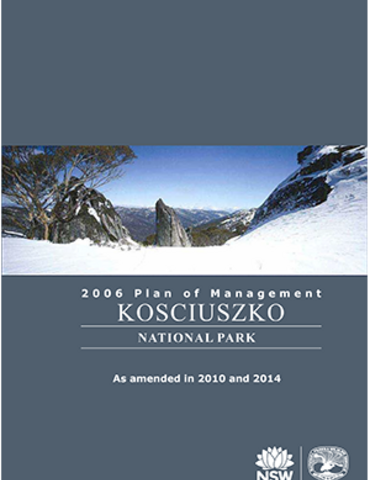Kosciuszko National Park Plan of Management
Kosciuszko National Park is part of the 1.6-million-hectare chain of national parks and reserves across the Australian alps. The NSW Government works with the Victorian, ACT and Australian Governments to protect this area through regional programs under the Australian Alps Memorandum of Understanding.
The park contains Australia’s highest mountains, unique glacial landscapes, and unusual assemblages of plants and animals, a number of which are found nowhere else. The park encompasses significant water catchments, the principal seasonally snow-covered region in Australia and extensive tracts of forest and woodland.
Many people have a strong attachment to Kosciuszko National Park. Local Aboriginal communities have deep cultural connections, and many non-Aboriginal people have links to the land associated with previous and present uses. The park has a rich Aboriginal and European history and, in some cases, the mountains, their people and their exploits have become part of Australian folklore and helped shape our national identity.
The park is one of the most popular national parks in New South Wales. Recreational activities undertaken in the park include vehicle-based sightseeing, bushwalking, cycling, fishing, canoeing, and caving. While winter presence of snow is a main drawcard for many visitors when the alpine resorts become the focus of visitor activities, summer activities, including cycling, are growing strongly.
This plan of management has been prepared to provide a framework to guide the long-term management of the broad range of values contained in the park. It contains a suite of actions to be undertaken by the NSW National Parks and Wildlife Service (NPWS) and other organisations to protect and conserve the values of the park.
First published in June 2006; reprinted May 2010, December 2010, February 2014, December 2014 and June 2021 with amendments.
Attachments to the Plan of Management
- Map 6 – Park Zoning Scheme (PDF 1.9MB)
- Map 7 – Visitor Facilities and Roads (PDF 1.6MB)
- Map 8 – Horse riding in wilderness locations (PDF 367KB)
- Map 9 – Park zoning around Jindabyne and the southern Alpine Resorts (PDF 654KB)
Schedule 8 outlines accommodation numbers in the alpine resorts. Bed numbers within the alpine resorts are periodically updated. A plan of management amendment is not required to update Schedule 8.
Schedule 8 – Accommodation bed numbers – Kosciuszko National Park (PDF 278KB)
Amendments
These amendments have been incorporated into the Kosciuszko National Park Plan of Management (2006):
Geotechnical and water management amendment to Kosciuszko National Park Plan of Management (2010)
Amendment to increase volunteer ski patrol beds Kosciuszko National Park Plan of Management (2010)
Amendments to Kosciuszko National Park Plan of Management: Allow pilot of horse riding in wilderness (2014)
Amendment to Kosciuszko National Park Plan of Management: Visitor Experience Improvements (2019)
These amendments have been adopted by the Minister for Environment and Heritage but are not yet incorporated into the Kosciuszko National Park Plan of Management (2006):
Kosciuszko National Park Amendment to the Plan of Management: Snowy 2.0 (2022)
Other planning documents
A range of planning documents which inform management of Kosciuszko National Park, such as precinct plans and cycling and walking track strategies, are available at the Kosciuszko National Park community engagement page.
Snowy Mountains Special Activation Precinct master plan
The Snowy Mountains Special Activation Precinct master plan was finalised in 2022. Its implementation is now being progressed by the Department of Planning and Environment through proposed changes to the statutory planning framework for alpine resorts in Kosciuszko National Park.
Several documents outlining the proposed changes have been prepared by the department for public consultation as a representative of the consent authority for development in the alpine resorts, with input from the National Parks and Wildlife Service on resort related matters.
Further information about the Snowy Mountains Special Activation Precinct and documents on public exhibition is available on the Snowy Mountains Special Activation Precinct page.
